Chapter: Essentials of Psychiatry: Psychoanalytic Theories
Psychoanalytic Theories: Development and Major Concepts
Development and Major Concepts
Freud’s Contributions
Dreams
Freud’s study (1900, 1901) of dreams during his
self-analysis and in his work with patients resulted in an elaborate
understanding of the workings of the mind. The analysis of dreams continues to
hold a prominent position in psychoanalytic practice. Dreams give expression to
unconscious wishes in disguised form and generally represent their fulfillment
or gratification. Analysis of dreams can provide conscious access to
unconscious drives, wishes, fantasies and associated repressed infantile
memories, providing what Freud called the “royal road to the unconscious”.
The dream that is remembered on awakening is
referred to as the manifest dream.
Its component elements include sensory stim-uli occurring during sleep, the day residue and the latent dream content. The day residue consists of experiences of events of the preceding day or days, often
associated in the mind with uncon-scious wishes. The latent dream content is
the set of unconscious infantile urges, wishes, and fantasies that seek
gratification during the dreaming state of blocked motor discharge and regression.
Freud hypothesized a dream censor whose function is to keep the unconscious latent
content from conscious awareness, thereby preventing the emergence of anxiety
and awakening from sleep. The surreal and fantastic quality of the remembered
manifest dream is a reflection of the influence of dream work and primary
process unconscious mentation (Table 18.1): depic-tion of immediate
gratifications, absence of the rules of logic of conscious thought, merging of
past and present, absence of nega-tives, loss of distinction between opposites
and representation of a whole by a part. The activity of the dream work
involves a set of mental mechanisms designed to disguise and distort the latent
content in keeping with the function of the dream censor

In psychoanalytic treatment, the analysis of dreams
attempts to take this process backward, starting with the patient’s narration
of the dream and then observing the patient’s associa-tions to the manifest
elements, with the goal of obtaining insight into the dreamer’s unconscious
wishes, memories and infantile fantasies, and processes of defense.
Childhood Sexuality
In his analyses of adult patients and observations
of children, Freud (1905) became convinced of the influence of early sexual
fantasies on the formation of neurotic symptoms and of the univer-sality of
sexual wishes throughout life including early childhood. The term sexuality is used in this context to
refer not exclusively to adult genital sexuality but to a variety of body
stimulations that are pleasurable and sensually gratifying. He postulated a
devel-opmental sequence of body zones that become primary foci of erotic
sensations and mental organization (Table 18.2): oral, anal (including perianal
and urethral) and genital (phallic). During de-velopment, there is a more or
less orderly progression from one zone to the next, with pleasure being derived
from sucking, biting, tasting, touching, looking, smelling, filling, emptying,
penetrating and being penetrated. In the neuroses, the repressed component
instincts become an unconscious source of symptom formation.
Fixation (Table
18.3) at a particular phase of development
may occur if there is insufficient mastery of issues pertinent to that
phase. Fixations result in continued manifestations of phase specific issues in
a person’s behavior, influencing later person-ality adjustment (e.g., the anal
organization of the obsessional character). Regression (Table 18.3), a return to a less mature level
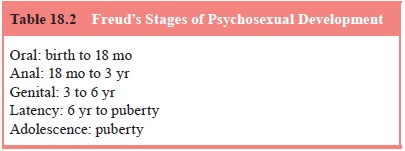
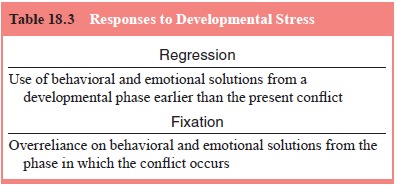
of mental organization, may occur in the context of
stressors or conflict that overtaxes the adaptive capacities of an individual.
The first of the phases described by Freud is the oral phase (Table 18.4), which encompasses approximately the first 18 months of life. During this phase, the mouth, lips and tongue
are the primary sources of sensual gratification. The activities of sucking,
swallowing, mouthing and biting, as well as the experi-ence of being held
during feeding, form a cognitive template for the organization of fantasy and relatedness
to others. The infant at this stage is dependent on mother for nurturance,
protection and sustenance. A favorable outcome of this stage is the
estab-lishment of a capacity to feel trust and safety in a dependent
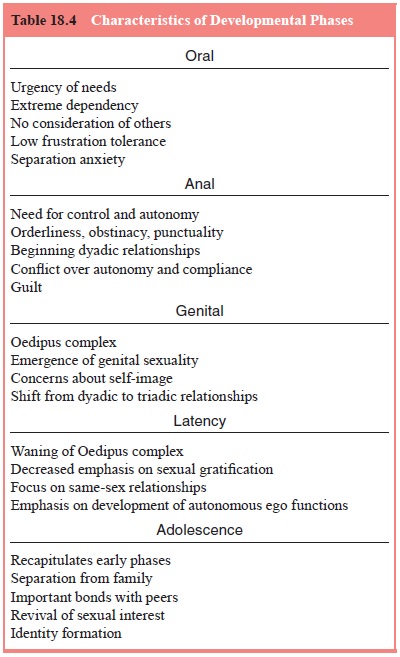
relationship,
a sureness that needs will be recognized and grati-fied, and a minimum of
conflict about aggressive wishes oc-curring during moments of frustration.
Excessive neglect or deprivation during this period may result in adult
feelings of interpersonal insecurity, mistrust, envy, depression, excessive
dependency, anticipation of rejection by others and proneness to moments of
diffuse rage.
The anal phase (see Table 18.4) emerges
with the develop-ment of increasing neuromuscular control of the anal and
ure-thral sphincters and takes place from about 18 months to 3 years. Fantasy
organizes around anal pleasure and anal functions such as withholding,
expelling and controlling. Because of the child’s increased motor skills,
language development and emerging autonomy, she or he is expected to take more
of an active part in self-care activities, including using the toilet. Related
to toi-leting, power struggles may ensue around the child’s soiling or
withholding. Anger is felt toward those in control of this educa-tive process,
but the child also wishes to please them. The child in the anal phase
experiences considerable ambivalence around expelling versus retaining (giving
versus keeping), obedience and submission versus defiance and protest, and
cleanliness and orderliness versus messiness. Fixation at this stage results in
a personality organized around anal erotism and its associated conflicts,
characterized by wishes to dominate and control peo-ple or life situations,
rigidity, defiance and anger toward author-ity, neatness, orderliness,
messiness, parsimony, frugality and obstinacy.
The phallic or phallic–oedipal or genital
phase (see Table 18.4) occurs from the ages of 3 to about 5 or 6 years. At
the onset of this period, sensual pleasure has become most highly focused
around the genitals, and masturbatory sensations more closely resemble the
usual sense of the word sexual. The
child at this time has become even more autonomous and has more so-phisticated
motor and language skills, conceptual capabilities and elaborate fantasies. The
child is better able to recognize feelings of love, hate, jealousy and fear;
has a more distinct recognition of the anatomical difference between the sexes;
and appreciates that the parents have an intimate sexual relationship from
which the child is excluded. Thinking about relatedness to others shifts from
the largely dyadic (mother–child) quality of the prephallic phases to an
appreciation of relational triangles.
Freud
recognized in his patients’ associations that there were regularly occurring
incestuous fantasies and wishes toward the parent of the opposite sex that were
involved in the forma-tion of neurotic difficulties. He termed this phenomenon
the Oedipus complex, in reference to
the story of Oedipus, who unknowingly
killed his father and married his mother. In the midst of the Oedipus complex,
the child wishes to possess exclu-sively the parent of the opposite sex and to
eliminate the parent of the same sex. The jealousy and murderous rage felt
toward the same-sex parent are accompanied by fears of retaliation and physical
harm. Because these fantasies are associatively linked to pleasurable genital
sensations, the child has specific uncon-scious fears of being castrated, which
Freud referred to as the castration
complex. The oedipal phase proceeds differently in boys and girls.
Successful
passage through the phallic phase includes resolution of the Oedipus complex
and repression of oedipal fan-tasies. The child internalizes the parental
prohibitions and moral values and demonstrates a greater capacity to channel
instinctual energies into constructive activities. Excessive conflict or
trau-matization during this phase may lead to a personality organized around
oedipal fantasies and conflicts or a proneness defensively to regress to anal
or oral organization.
During the latency
phase (see Table 18.4), from age 6 years to puberty, play and learning take
a prominent position in the child’s behavioral repertory as cognitive process
ma-tures further. Although Freud believed that the sexual urges become
relatively quiescent during this phase, observation indicates that they are
expressed in derivative form in the child’s play. At puberty and through
adolescence, genital urges once again predominate, but there is now a
consolida-tion of sexual identity and a movement toward adult sexuality (Figure
18.1)
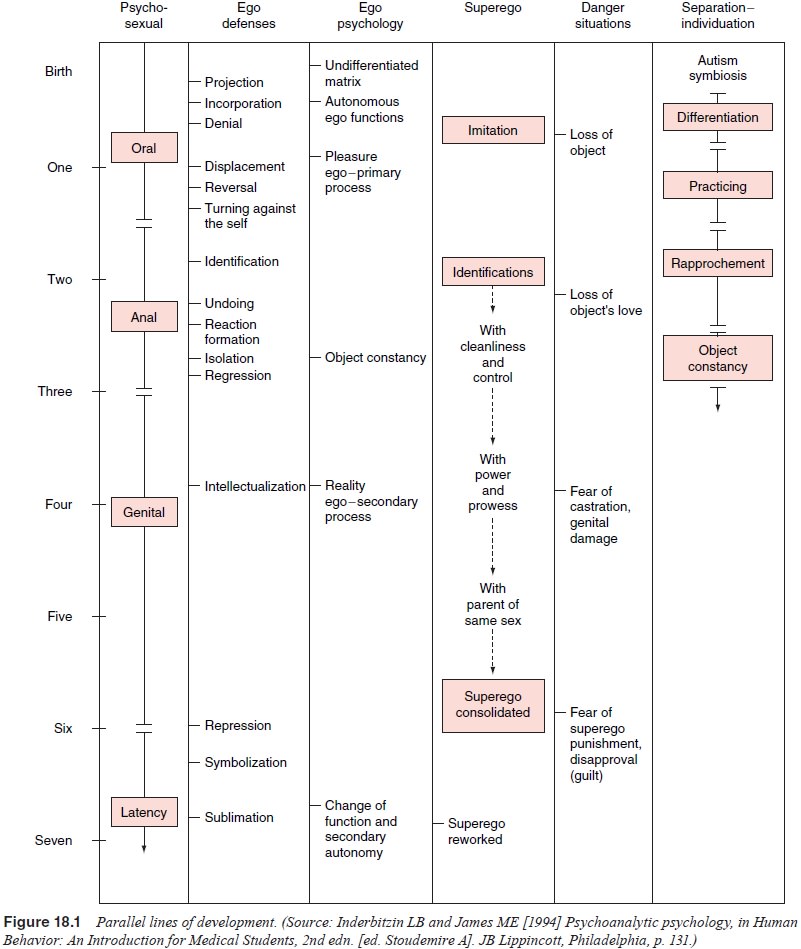
Libido Theory
Freud’s continued consideration of the sources and
nature of the sexual drives led to his dynamic model of the mind referred to as

libido
theory (Table 18.5). This theory attempted to explain the observation that behavior and mental activity are not only
trig-gered by external stimuli (as in the reflex arc) but also generated by
primary internal processes. Freud defined instinct as “a con-cept on the
frontier between the mental and the somatic, as the psychical representative of
the stimuli originating within the or-ganism and reaching the mind, as a
measure of the demand made upon the mind for work in consequences of its
connection with the body”. Regardless of the specifics of their origins,
derivatives of the instincts are experienced mentally as compelling urges and a
source of motivation.
Although Freud had given up the idea that sexual
trau-matization was always the cause of psychoneurotic symptoms, he maintained
the view that the sexual instinct played an etio-logical role in the neuroses
and that sexual stimulation exerted a predominant force on mental activity
throughout life. Freud termed this force libido.
The discharge of libido is experienced as pleasure; the welling up of libido
without discharge is felt as tension or unpleasure. According to the pleasure principle, the individual
seeks pleasure (through the discharge of libidinal tension) and avoids
unpleasure. The primary process quality of unconscious mentation follows the
pleasure principle as it maintains its focus on the gratification of wishes. As
the mind develops, conscious mentation becomes more governed by the reality principle (Freud, 1911)
involving a shift from fantasy to
perception of and action on reality. The secondary process form of conscious
thought follows the reality principle. Under the influence of the reality
principle, gratification of wishes may be delayed with the aim of eventually
achieving greater and/or safer pleasure.
The sexual instinct has four defining components: source, pressure (or impetus), aim, and object. Source refers
to the bio-logical substrate of the instinct. Pressure is the amount of force or “demand for work” of the
instinct. The aim is the action
designed to accomplish release of tension and satisfaction. An object is the target of desire, the
person or thing through which gratification is accomplished. Although the
libido theory has been criticized because it was based on 19th century German
scientism, it has served as a useful metaphor to understand pleasure,
attachments, and the dynamic processes of mental activity.
From the Topographical to the Structural Model
According to the topographical theory, three
regions or systems of the mind exist as defined by their relationship to
conscious thought: the conscious, preconscious and unconscious. The conscious mind registers sensations
from the outside world and from internal
processes, and is the agency of ordinary wakeful thought. Conscious mentation
follows the reality principle and uses secondary process logic. The preconscious includes mental contents
that can gain access into consciousness by the focus-ing of attention. The unconscious is defined from three basic
angles: descriptively, it consists of all mental processes and con-tents
operating outside conscious awareness; dynamically, these processes and
contents are kept actively repressed or censored by the expenditure of mental
energy to prevent the anxiety or repugnance that would accompany their
conscious recognition; and as a mental system, it is a part of the mind that
operates in accordance with the pleasure principle using primary process logic.
Over time, Freud encountered clinical phenomena
that were not adequately accounted for by the topographical model. Freud
revised his theory of mental systems to include the struc-tural model, but the
useful conception of the dynamic uncon-scious and the particular qualities of
conscious, preconscious and unconscious mentation have been retained.
Theory of Narcissism
In all mental functioning, it is possible to
observe the balance be-tween libido deployed toward objects and libido directed
toward the self. For example, when a person is in love, much libido is
at-tached to the loved object, even to the extent that the person feels himself
or herself diminished (from decreased ego libido). During physical illness or
hypochondriacal states, libido is pulled toward the ego so the person appears
preoccupied with the body and un-interested in the world. According to the
pleasure principle, the mind seeks to discharge libido, and if it is dammed up,
symptoms will result. In neurotic persons, excess object libido has accumu-lated
and, undischarged, produces anxiety. In psychotic persons, ego libido has been
prevented from being discharged outward, so it is discharged inward, resulting
in hypochondriacal anxiety and megalomania.
Internal judgmental processes and self-regard are
also ad-dressed by the theory of narcissism. In normal adults, most evi-dence
of the operation of ego libido has been repressed. A new target of self-love
has been constructed, the ego ideal,
a forerun-ner of the superego concept, consisting of ideas and wishes for how
one would like to be. Similarly, love objects may become the subject of
idealization. Freud theorized a separate psychic agency, which he called the
superego (see below), that attends to ensuring narcissistic satisfaction and
measuring self-reflection, censoring and repression. Living up to the ideal,
loving oneself and being loved, reflects attempts to restore a state comparable
to the primary narcissism of infancy.
Melancholia
In Mourning
and Melancholia Freud (1917), developed a theory to explain processes of
guilt, internal self-punishment and de-pression. To do this, he contrasted
states of grief or mourning with the condition of melancholia, now called
depression. Both have in common the experience of pain and sadness, and both
are brought on by the experience of loss, but the person in mourning maintains
her or his positive self-regard, whereas the person with melancholia feels
dejected, loses interest in the world, shows a di-minished capacity to love,
inhibits all activities and exhibits low self-regard in the form of
self-reproaches. In mourning, libido is gradually withdrawn from the object
attachment; in melancho-lia, the ego feels depleted or comes under attack as
though “one part of the ego sets itself over against the other, judges it
criti-cally, and as it were, takes it as its object”. This critical agency
(again a theoretical forerunner of the superego) comes to operate independently
of the ego.
The self-accusations of the person with melancholia seem to fit best with criticism that might be leveled against the lost object. In the case of suicidal impulses, the melancholic person seems to be directing at himself or herself the sadism and mur-derous wishes felt toward the disappointing or lost other. Freud theorized that in the context of the loss of an ambivalently held object, the ego incorporates, or forms a narcissistic identifica-tion with, the object. Hostility originally felt toward the object is now directed at the self, giving rise to feelings of torment, suffering and self-debasement. A predisposition to melancholia may thus result from forming narcissistic object attachments and identifications.
Dual-instinct Theory
Freud had originally considered two types of
instincts, the sexual and the ego (self-preservative) instincts, and considered
sadism to represent a fusion of the two, with hostility occurring in the
context of frustrated libidinal strivings. However, this theory did not
adequately address psychological situations in which destructive tendencies
seem to be operating independently of li-bidinal or self-preservative drives.
Freud concluded that there must be a separate
instinct of aggression, whose aim is destructiveness. The aggressive drive is
at work in impulses to harm, in the desire for control and power, in sadistic
or masochistic behaviors, in guilt and depression, and in the persecutory fears
of paranoid individuals.
Structural Model
On the basis of the preceding considerations, Freud
revised his theory of the mind into what is now known as the structural or
tripartite model (Table 18.6). He conceived of three mental agen-cies operating
in the psyche: the id, the ego and the superego. The id is the biological source of instinctual drives, operating
uncon-sciously and following the pleasure principle. The activity of the
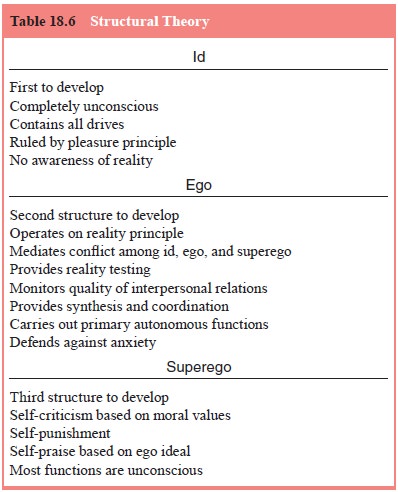
id generates the motivational push for
gratification of sexual and aggressive wishes.
The ego
grows out of the id early in human development. Its functions include
perception, interpretation of perceptions, voluntary movement, modulation of
affects and impulses, cog-nition, memory, judgment and adaptation to reality.
Subject to conflicting forces from the id, the superego and reality, the ego
synthesizes mental compromises that provide gratification of instinctual wishes
in accord with reality considerations and the moral demands of the superego.
The superego,
which develops as an outgrowth of both the ego and id, consists of the moral
standards, values and pro-hibitions that have been internalized throughout
childhood and adolescence. It is the source of internal punishment, which is
felt as guilt, and of internal reward. Early in development, the su-perego has
a harsh and archaic quality. During maturation under optimal conditions, it
becomes less harsh and comes to include loving components as well. In the
structural model, the ego ideal (discussed earlier) is considered a component
of the superego, accounting for feelings of shame and pride.
Anxiety and Symptom Formation
With the elaboration of the structural theory,
Freud progres-sively viewed the nature of anxiety and the origin of symptoms
(Figure 18.2) differently. According to his original theory, anxiety resulted
from the accumulation of undischarged sexual tensions caused by inadequate
sexual activity in the actual neu-roses or by inhibitions due to repression in
the psychoneuroses. Later, it became clear that anxiety was more closely
related to fear occurring in response to perceived dangers, either external or
internal. This led to a focus on the ego, one of whose functions is to
anticipate and negotiate danger situations. A dangerous or traumatic situation
is one in which excessive stimulation threat-ens to overwhelm the ego’s
capacity for delay and compromise.
The ego has as one of its tasks the continual
formation of compromises among id
wishes, the prohibitions and moral standards of the superego, and the dictates
of reality. If these
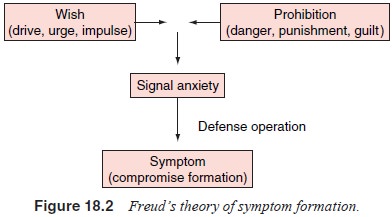
compromises are successful, anxiety will operate
predominantly on a signal level and behavior will be both sufficiently
gratifying and acceptable in reality. A symptom
neurosis occurs if these compromises are felt as uncomfortable, painful, or
maladaptive.
Post-freudian Ego Psychology
Ego, Defense and Adaptation
Anna Freud laid out a categorization of defense
mechanisms (1936) (Table 18.8). In discussing the preliminary stages of
de-fense that are first used by the ego to avoid pain from the external world,
she succeeded in integrating two main themes in the de-velopment of the ego
concept: defense and relations with external reality. Anna Freud advocated a
shift of the analyst’s attention to the ego as the proper field for
observation, in order to gain a picture of its functioning in relation to the
other two psychic structures, id and
superego. This more detailed
methodical at-tention to the mind’s surface, which includes manifestations of
unconscious ego activities, provides a much clearer view of the actual workings
of the mind. Her recommendation that the analyst listen from a point
equidistant from id, ego and superego emphasized the importance of observing
neutrally the influence of all three psychic agencies. The ego wards off not
only deriv-atives of instinctual drives but also affects that are intimately connected with the drives. She
advocated that priority be given to the interpretation of the defenses against
affects, as well as defenses against instinctual drives.
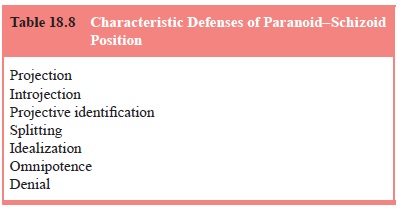
Related Topics